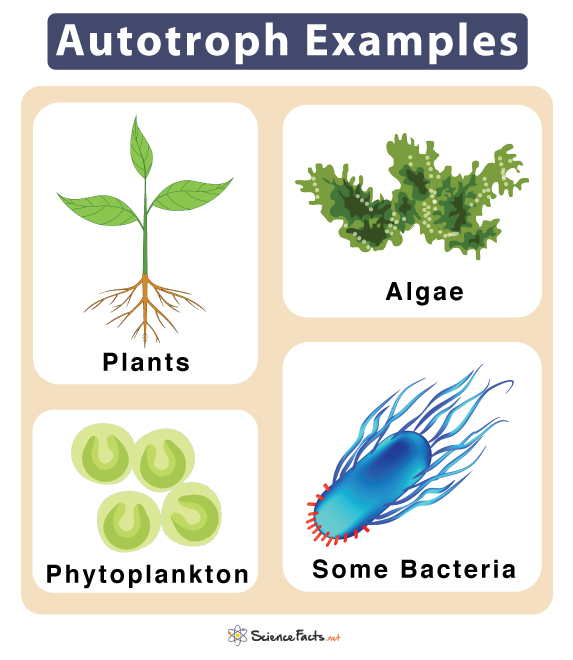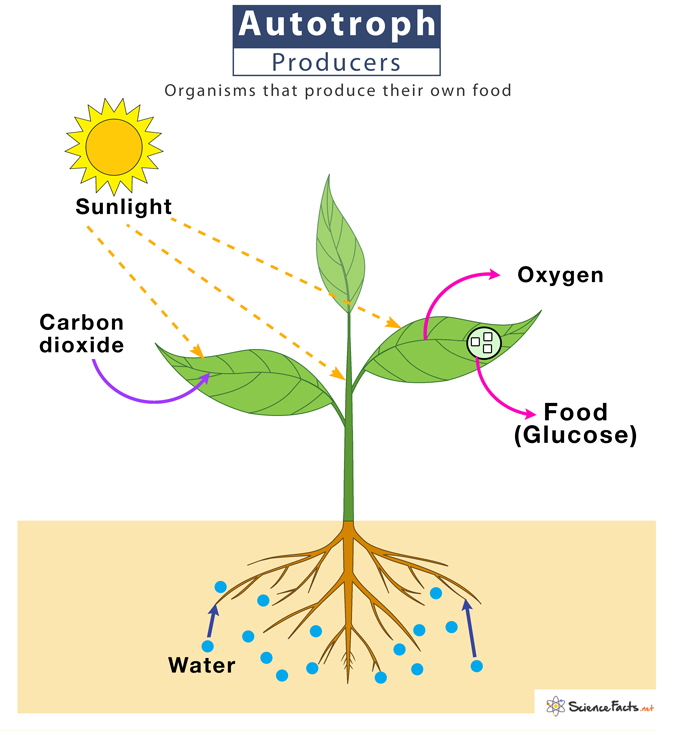Autotrophs (Primary Producer)
Autotrophs are organisms that can make their own food using inorganic materials. They either use water, carbon dioxide, and energy from sunlight or use a variety of chemicals to prepare food. Since autotrophs produce their own food, they are also called primary producers.
Examples of Autotrophs
All green plants are autotrophs, from the tiniest mosses to giant pine trees. Other examples include algae, phytoplankton living in water bodies, and some types of bacteria. Thus, autotrophs include eukaryotes with membrane-bound organelles and prokaryotes, with a single cell devoid of membrane-bound organelles.
How do Autotrophs Obtain Energy
Most primary producers make their food by a process called photosynthesis. It occurs within an organelle called chloroplast that contains the green pigment chlorophyll.
During the process, plants absorb sunlight with the help of chlorophyll, which provides energy to convert water from soil and carbon dioxide from the air to form glucose and oxygen. Glucose is a type of sugar. It gives energy to plants and makes cellulose, a substance they use to grow and build cell walls. Oxygen is necessary for the cellular respiration of most organisms on Earth.
Autotrophs in the Food Chain
Since a food chain describes how organisms depend upon each other for food, organisms are grouped accordingly into three trophic or nutritional levels.
Autotrophs are primary producers in the food chain and do not consume other organisms. They occupy the base of the food chain and are also the foundation of every food web in every ecosystem. They occupy what is called the first tropic level of the food chain. Autotrophs are followed by herbivores, the primary consumers at the second trophic level, and the carnivores and omnivores, the secondary consumers at the third trophic level.
For example, grasses in forests are autotrophs consumed by deer (herbivores), the primary consumers. Tiger (carnivores), which feed upon deer, are secondary consumers.
Types of Autotrophs
Autotrophs can be classified into two groups:
1. Photoautotrophs (Phototrophs): They use sunlight as their energy source to produce food using carbon dioxide and water by a process known as photosynthesis. Most organisms that use this method to produce food have a membrane-bound chloroplast and nucleus.
Photoautotrophs are found almost everywhere on the Earth. Higher plants such as maize, trees, grass, and green algae (cyanobacteria) are typical examples of photoautotrophs.
2. Chemoautotrophs (Chemotrophs): Instead of sunlight, they use chemicals such as methane or hydrogen sulfide as the energy source and oxygen to produce carbon dioxide and energy by chemosynthesis.
Chemoautotrophs are typically found in extreme environments like deep-sea hydrothermal vents and volcanoes. Some examples of chemotropic bacteria and archaea are sulfur-oxidizing bacteria, nitrogen-fixing bacteria, iron-oxidizing bacteria, and sulfur-oxidizing archaea.
Autotroph vs. Phototroph
Autotrophs are organisms that can make their food either by using sunlight by a process called photosynthesis or through chemicals by a process called chemosynthesis. In contrast, phototrophs are autotrophs that use only sunlight to make their food by photosynthesis. Thus, all phototrophs are autotrophs, but not all autotrophs are necessarily autotrophs.
FAQs
Ans. Primary producers or autotrophs are the only organisms that directly absorb and store energy from the sun to produce their food. They thus have the most energy among all other groups of organisms.
Ans. Viruses have no metabolism, so they are neither autotroph nor heterotroph.
Ans. No, mushrooms cannot prepare their food and thus are not autotrophs.
-
References
Article was last reviewed on Friday, February 17, 2023





